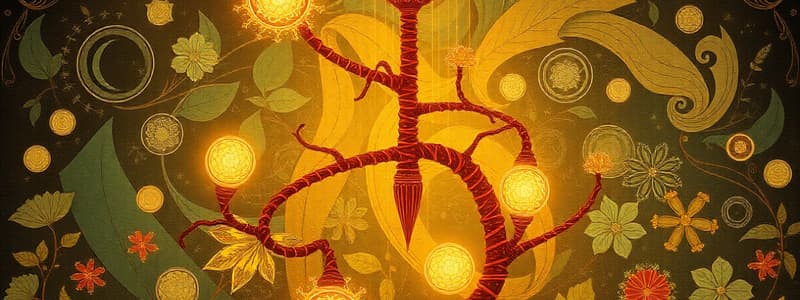Podcast
Questions and Answers
What is the primary function of gas exchange?
What is the primary function of gas exchange?
- Taking in carbon dioxide and releasing nitrogen.
- Taking in hydrogen and releasing oxygen.
- Taking in nitrogen and releasing oxygen.
- Taking in oxygen and releasing carbon dioxide. (correct)
Which of the following is NOT a basic principle of gas exchange?
Which of the following is NOT a basic principle of gas exchange?
- Moist environment.
- Dry environment. (correct)
- Thin and permeable membranes.
- Concentration gradient.
What structures regulate the opening and closing of stomata in plants?
What structures regulate the opening and closing of stomata in plants?
- Chloroplasts.
- Guard cells. (correct)
- Mesophyll cells.
- Vascular bundles.
Which pigment in the blood helps transport oxygen?
Which pigment in the blood helps transport oxygen?
Which gas exchange system is used by insects?
Which gas exchange system is used by insects?
In mammals, where does gas exchange occur in the lungs?
In mammals, where does gas exchange occur in the lungs?
What is the function of the diaphragm?
What is the function of the diaphragm?
Which animals use integumentary exchange for gas exchange?
Which animals use integumentary exchange for gas exchange?
What is the definition of animal nutrition?
What is the definition of animal nutrition?
Which of the following nutrients is the main energy source for the body?
Which of the following nutrients is the main energy source for the body?
Which nutrient aids digestion and prevents constipation?
Which nutrient aids digestion and prevents constipation?
Which mineral is important for oxygen transport in blood?
Which mineral is important for oxygen transport in blood?
Which vitamin type needs regular intake as it is not stored in the body?
Which vitamin type needs regular intake as it is not stored in the body?
Which feeding mechanism describes animals that strain small organisms from water?
Which feeding mechanism describes animals that strain small organisms from water?
What is the function of the esophagus?
What is the function of the esophagus?
Where is bile produced?
Where is bile produced?
In the small intestine, what increases the absorption surface area?
In the small intestine, what increases the absorption surface area?
What does the pancreas secrete?
What does the pancreas secrete?
What is the main function of the large intestine?
What is the main function of the large intestine?
Where is waste stored until elimination?
Where is waste stored until elimination?
Flashcards
Gas Exchange
Gas Exchange
The process of taking in oxygen (O₂) and releasing carbon dioxide (CO₂).
Stomata
Stomata
Pores on plant leaves where gas exchange occurs.
Guard cells
Guard cells
Regulate the opening and closing of stomata.
Integumentary Exchange
Integumentary Exchange
Signup and view all the flashcards
Gills
Gills
Signup and view all the flashcards
Tracheal System
Tracheal System
Signup and view all the flashcards
Alveoli
Alveoli
Signup and view all the flashcards
Animal Nutrition
Animal Nutrition
Signup and view all the flashcards
Carbohydrates
Carbohydrates
Signup and view all the flashcards
Fats
Fats
Signup and view all the flashcards
Fiber
Fiber
Signup and view all the flashcards
Proteins
Proteins
Signup and view all the flashcards
Minerals
Minerals
Signup and view all the flashcards
Vitamins
Vitamins
Signup and view all the flashcards
Substrate Feeders
Substrate Feeders
Signup and view all the flashcards
Filter Feeders
Filter Feeders
Signup and view all the flashcards
Fluid Feeders
Fluid Feeders
Signup and view all the flashcards
Bulk Feeders
Bulk Feeders
Signup and view all the flashcards
Pharynx
Pharynx
Signup and view all the flashcards
Duodenum
Duodenum
Signup and view all the flashcards
Study Notes
- Gas exchange involves taking in oxygen (O₂) and releasing carbon dioxide (CO₂).
- It is essential for respiration in both plants and animals as well as photosynthesis in plants.
Basic Principles of Gas Exchange
- Gases need a moist environment to dissolve in water before diffusing.
- Thin, permeable membranes facilitate easy gas passage.
- A large surface area enhances gas diffusion efficiency.
- A concentration gradient maintains gas flow.
Gas Exchange in Plants
- Plants undergo both respiration and photosynthesis.
- Plants use CO₂ and produce O₂ during photosynthesis.
- Plants use O₂ and release CO₂ during respiration.
Structures Involved in Plant Gas Exchange
- Stomata are pores on leaves that facilitate gas exchange.
- Guard cells regulate the opening and closing of stomata.
- Mesophyll cells contain chloroplasts for photosynthesis.
- The waxy cuticle prevents excessive water loss.
- The upper epidermis is a protective layer with fewer stomata.
- The lower epidermis contains more stomata for gas exchange.
- Vascular bundles transport water (xylem) and nutrients (phloem).
- Chloroplasts are the site of photosynthesis.
Gas Exchange in Animals
- Oxygen diffuses into the body, and CO₂ is expelled.
- Hemoglobin in blood helps transport O₂.
Types of Gas Exchange Systems in Animals
- Integumentary Exchange occurs through the skin, as seen in flatworms, earthworms, and amphibians like frogs and toads.
- Gills are specialized structures in aquatic animals like fish and amphibians.
- Gills use counter-current exchange to absorb O₂ from water.
- The tracheal system in insects involves a network of air tubes (tracheae).
- Air enters through spiracles and reaches body cells in insects.
- Lungs are found in mammals, reptiles, birds, and amphibians.
- Oxygen enters alveoli, diffuses into the blood, and CO₂ is expelled.
Structures for Gas Exchange in Animals
- The nasal cavity warms and moistens air.
- The pharynx is a common passage for air and food.
- The larynx contains vocal cords.
- The trachea is the air passage to lungs.
- Bronchi are large airways leading to lungs.
- Bronchioles are smaller branches of bronchi.
- Alveoli are tiny sacs where gas exchange occurs.
- The diaphragm is a muscle that aids breathing.
Introduction to Animal Nutrition
- Animal nutrition is the process by which animals obtain, process, and digest food.
- Nutrition is essential for survival, growth, reproduction, and maintaining bodily functions.
- Major nutrients include carbohydrates, fats, proteins, fiber, minerals, vitamins, and water.
Major Classes of Nutrients
Carbohydrates
- Carbohydrates are the main energy source for the body.
- They are converted into glucose for immediate energy use.
- Sources include rice, bread, pasta, fruits, and vegetables.
Fats
- Fats provide concentrated energy, support cell functions, and aid in the absorption of fat-soluble vitamins.
- Saturated fats are solid at room temperature, found in animal products, and increase LDL (bad cholesterol).
- Unsaturated fats are liquid at room temperature and found in fish, nuts, and vegetable oils.
- Monounsaturated fats are found in olive oil, nuts, and avocados.
- Polyunsaturated fats include omega-3 and omega-6, found in fatty fish and seeds.
- Trans fats are artificially modified and harmful to health.
Fiber
- Fiber aids digestion, prevents constipation, and slows down nutrient absorption.
- Sources for fiber include vegetables, fruits, whole grains, and legumes.
Proteins
- Proteins are essential for growth, muscle repair, and enzyme and hormone production.
- Sources include meat, fish, eggs, dairy, and legumes.
- Proteins are needed for body development and milk production in pregnant and breastfeeding women.
Minerals
- Minerals support bone health, nerve function, and metabolic processes.
- Calcium supports bone health.
- Iron supports oxygen transport in blood.
- Potassium and sodium support electrolyte balance.
Vitamins
- Vitamins are essential for various bodily functions, including immunity and metabolism.
- Fat-soluble vitamins (A, D, E, K) are stored in fat and require dietary fat for absorption.
- Water-soluble vitamins (B-complex, C) need regular intake as they are not stored in the body.
Water
- Water is essential for digestion, circulation, and temperature regulation.
- The daily water requirement is 2–3 liters per day.
- Water produces cells and body fluids.
- Aids in sweating and cooling.
- Supports metabolic processes.
- Keeps tissues moist.
- Helps remove waste through urine.
Feeding Mechanisms in Animals
- Substrate feeders live on or inside their food source (e.g., earthworms, caterpillars).
- Filter feeders strain small organisms from water (e.g., whales).
- Fluid feeders suck nutrient-rich fluids from a host (e.g., mosquitoes, leeches).
- Bulk feeders consume large pieces of food (e.g., humans, snakes, lions).
Food Processing in the Human Digestive System
Oral Cavity, Pharynx, and Esophagus
- In the mouth, food is chewed and mixed with saliva.
- The pharynx connects the mouth to the esophagus, ensuring food goes to the stomach and not the lungs.
- The esophagus uses peristalsis (muscle contractions) to move food to the stomach.
Stomach
- The stomach stores and mixes food.
- It secretes gastric juice (HCl and enzymes) to break down food.
- Converts food into chyme (semi-liquid form).
Small Intestine
- The duodenum completes digestion of carbs, fats, and proteins.
- The jejunum and ileum absorb nutrients into the bloodstream.
- Villi and microvilli increase absorption surface area.
Accessory Digestive Organs
- The liver produces bile to digest fats.
- The gallbladder stores bile.
- The pancreas secretes digestive enzymes and insulin.
Large Intestine (Colon)
- The large intestine absorbs water and minerals and processes waste.
- It contains beneficial bacteria that aid digestion.
Rectum and Anus
- The rectum stores waste until elimination.
- The anus expels feces from the body.
Studying That Suits You
Use AI to generate personalized quizzes and flashcards to suit your learning preferences.




